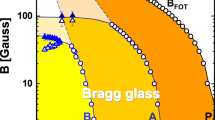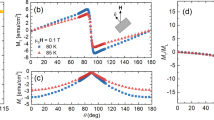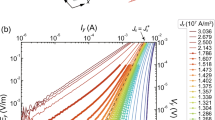Abstract
General arguments1 suggest that first-order phase transitions become less sharp in the presence of weak disorder, while extensive disorder can transform them into second-order transitions; but the atomic level details of this process are not clear. The vortex lattice in superconductors provides a unique system in which to study the first-order transition2,3,4,5,6 on an inter-particle scale, as well as over a wide range of particle densities. Here we use a differential magneto-optical technique to obtain direct experimental visualization of the melting process in a disordered superconductor. The images reveal complex behaviour in nucleation, pattern formation, and solid–liquid interface coarsening and pinning. Although the local melting is found to be first-order, a global rounding of the transition is observed; this results from a disorder-induced broad distribution of local melting temperatures, at scales down to the mesoscopic level. We also resolve local hysteretic supercooling of microscopic liquid domains, a non-equilibrium process that occurs only at selected sites where the disorder-modified melting temperature has a local maximum. By revealing the nucleation process, we are able to experimentally evaluate the solid–liquid surface tension, which we find to be extremely small.
This is a preview of subscription content, access via your institution
Access options
Subscribe to this journal
Receive 51 print issues and online access
$199.00 per year
only $3.90 per issue
Buy this article
- Purchase on Springer Link
- Instant access to full article PDF
Prices may be subject to local taxes which are calculated during checkout




Similar content being viewed by others
References
Imry, Y. & Wortis, M. Influence of quenched impurities on first-order phase transitions. Phys. Rev. B 19, 3580–3585 (1980).
Blatter, G. et al. Vortices in high-temperature superconductors. Rev. Mod. Phys. 66, 1125–1388 (1994).
Nelson, D. R. Vortex entanglement in high-T c superconductors. Phys. Rev. Lett. 60, 1973–1976 (1988).
Safar, H. et al. Experimental evidence for a first-order vortex-lattice-melting transition in untwinned single crystal YBa2Cu3O 7. Phys. Rev. Lett. 69, 824– 827 (1992).
Kwok, W. K. et al. Vortex lattice melting in untwinned and twinned single-crystals of YBa2Cu3O7-δ. Phys. Rev. Lett. 69, 3370–3373 ( 1992).
Zeldov, E. et al. Thermodynamic observation of first-order vortex-lattice melting transition. Nature 375, 373– 376 (1995).
Zeldov, E. et al. Geometrical barriers in high-temperature superconductors. Phys. Rev. Lett. 73, 1428–1431 (1994).
Indenbom, M. V. et al. Direct study of magnetic flux penetration and trapping in HTSC. Physica C 166, 486– 496 (1990).
Duran, C. A. et al. Real-time imaging of the magnetic flux distribution in superconducting YBa2Cu3O7-δ. Nature 357, 474–477 (1992).
Welp, U. et al. Imaging of transport currents in superconducting (Bi, Pb) 2SrCa2Cu3Ox composites. Nature 376, 44–46 ( 1995).
Morozov, N. et al. Paramagnetic ac susceptibility at first-order vortex-lattice phase transition. Phys. Rev. B 54, R3784–R3787 (1996).
Khaykovich, B. et al. Vortex-matter phase transitions in Bi2Sr2 CaCu2O8: Effects of weak disorder. Phys. Rev. B 56, R517–R520 (1997).
Oral, A. et al. Disorder-driven intermediate state in the lattice melting transition of Bi2Sr2CaCu2O8+δ single crystals. Phys. Rev. B 56, R14295– 14298 (1997).
Landau, L. D. & Lifshitz, E. M. Statistical Physics 3rd edn (Pergamon, Oxford, 1993).
Acknowledgements
We thank D. R. Nelson, Y. Imry, V. Vinokur, L. Balents, C. Varma, C. van der Beek and M. Indenbom for valuable discussions. This work was supported by the Israel Science Foundation and Center of Excellence Program, by the Ministry of Science, Israel, by the MINERVA Foundation, Munich, Germany, and by the Grant-in-Aid for Scientific Research from the Ministry of Education, Science, Sports and Culture, Japan.
Author information
Authors and Affiliations
Corresponding author
Rights and permissions
About this article
Cite this article
Soibel, A., Zeldov, E., Rappaport, M. et al. Imaging the vortex-lattice melting process in the presence of disorder . Nature 406, 282–287 (2000). https://doi.org/10.1038/35018532
Received:
Accepted:
Issue Date:
DOI: https://doi.org/10.1038/35018532
This article is cited by
-
Edge supercurrent reveals competition between condensates in a Weyl superconductor
Nature Physics (2024)
-
Disordering of the vortex lattice through successive destruction of positional and orientational order in a weakly pinned Co0.0075NbSe2 single crystal
Scientific Reports (2015)
-
Quantitatively mimicking wet colloidal suspensions with dry granular media
Scientific Reports (2015)
-
Critical Current Densities and Vortex Dynamics in Ba(Fe1−x Co x )2As2 Single Crystals
Journal of Superconductivity and Novel Magnetism (2010)
-
Tunable two-phase coexistence in half-doped manganites
Pramana (2008)
Comments
By submitting a comment you agree to abide by our Terms and Community Guidelines. If you find something abusive or that does not comply with our terms or guidelines please flag it as inappropriate.



